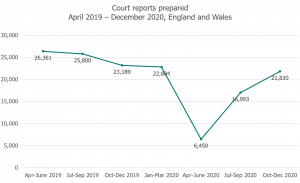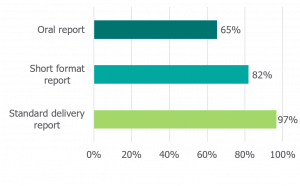Court reports
Key findings
- High-quality pre-sentence reports have been found to be more likely to influence sentencers to use alternatives to custody.
- Recent studies have reported that sentencer confidence in probation is relatively low, with sentencers not having sufficient information about the services offered.
Background
There are three areas of probation activity in the courts:

This page focuses mainly upon probation reports to courts. Pre-sentence reports (PSRs) are prepared for courts by probation practitioners to help judges and magistrates decide on the most appropriate sentence, considering levels of risk and offending-related needs. PSRs can be delivered orally or in a written format. Written PSRs can be fast delivery (short format) or standard delivery format for more complex cases.
Current policy is that most (60 per cent) PSRs should be delivered orally, a third should be fast delivery and the remaining 10 per cent should be standard delivery. However, the probation reform programme envisages that more standard delivery reports will be administered in the future.
Key statistics are as follows:
- 98,154 PSRs were produced in 2019/2020
- 3 per cent were standard delivery reports
- 45 per cent were fast delivery (short format) written reports
- 52 per cent were oral reports
- the Covid-19 pandemic and the resultant shutdowns of courts led to a 76 per cent fall in PSRs. Numbers are now returning to pre-pandemic levels as the courts re-open.

Concordance between the sentence proposed and the sentence imposed helps to demonstrate the influence of probation officers and sentencer confidence in probation advice. Data for January to December 2020 indicates that:
- community sentences were proposed in 91 per cent of cases and were imposed in 53 per cent of cases
- suspended sentence orders, which are technically custodial sentences, were imposed in 32 per cent of cases where a community sentence had been recommended.
Summary of the evidence
Pre-sentence reports
There is very little recent research into probation court reports. A 1995 study using a customised quality assurance tool found that better quality PSRs were more likely to influence sentencers to use community sentences rather than imprisonment. Good reports were those which:
- identified their information sources
- were concise
- showed a clear timeline
- were logical, consistent and well written.
Background information on the convicted person should be relevant to the offence[s] and give a sense of them as an individual.
Sentencer awareness and confidence
A study of Transforming Rehabilitation found that the relationship between frontline delivery and the courts had been fractured; National Probation Service (NPS) court teams were increasingly unaware of the services provided by Community Rehabilitation Companies (CRCs). Further research reported probation court staff feeling that they had lost sources of information and quality control that they had benefitted from in earlier years.
A 2016 survey of 582 magistrates found that confidence in probation services was generally low. For example, over a third of magistrates (37 per cent) were not confident that community sentences were an effective alternative to custody. Around half reported they did not have sufficient information about the services and interventions on offer from probation.
Within our standards framework for our probation inspections, we have a key question considering whether the pre-sentence information and advice provided to court is sufficiently analytical and personalised to the service user. Across our 2018/2019 inspections of the NPS divisions, key findings were as follows:
- In seven in 10 cases, the pre-sentence information and advice was judged to be sufficiently analytical and personalised, supporting the court’s decision-making. Across the underpinning prompt questions, positive judgements ranged from 66% for considering the impact of the offence(s) on known/identifiable victims (with victim statements and Crown Prosecution Service (CPS) documents not always available to report writers) to 87% for the service user being meaningfully involved.
- The quality of pre-sentence information and advice varied by type of report; nearly all of the standard delivery reports were judged to be sufficiently analytical and personalised to the service user, but this dropped to about two in three of the oral reports.

- Reports were less likely to be judged sufficiently analytical and personalised for those with a high likelihood of reoffending. These service users tend to have multiple and complex needs, requiring careful consideration to be given to the most appropriate interventions and how they can be integrated into a coherent and holistic programme of work.
- The pre-sentence advice was more likely to be judged sufficient when it had drawn appropriately upon available sources of information and it had considered factors related to both risk of harm and the likelihood of reoffending. A positive response to these prompts was least likely for oral reports. Information from other agencies could not always be shared in the time necessary to be included in these reports, and there was less time for report authors to consider and reflect upon the information to hand.
- The pre-sentence advice was more likely to be judged sufficient when the final proposal was deemed appropriate and there was a sufficient record of the advice and the reasoning. Once again, a positive response to these prompts was least likely for oral reports. In some cases, it was clear that insufficient attention had been given to the appropriateness of accredited programmes or other treatment requirements.
du Mont, S. and Redgrave, H. (2017). Where did it all go wrong? A study into the use of community sentences in England and Wales. London: Crest Advisory.
Gelsthorpe, L., Raynor, P., Robinson, G. (2010). ‘Pre-sentence reports in England and Wales: Changing discourses of risk, need and quality’, in McNeill, F., Raynor, P., Trotter, C. (eds.) Offender Supervision: New Directions in Theory, Research and Practice. Abingdon: Willan, pp. 471-491.
Robinson, G. (2019). ‘Delivering McJustice? The probation factory at the Magistrates’ Court’, Criminology and Criminal Justice, 19(5), pp. 605-621.
Back to Specific types of delivery Next: Unpaid work
Last updated: 17 May 2021



